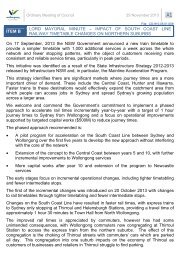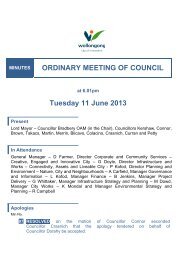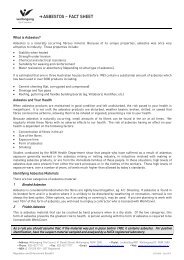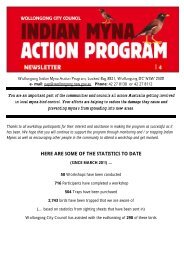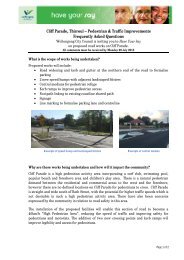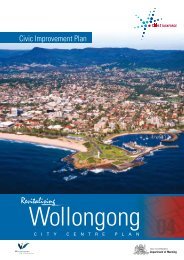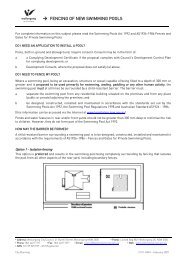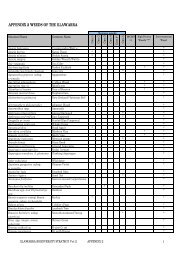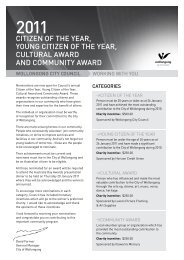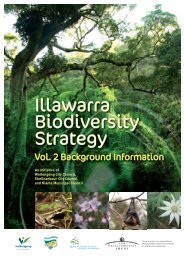Minnegang Creek Flood Study Report - Wollongong City Council
Minnegang Creek Flood Study Report - Wollongong City Council
Minnegang Creek Flood Study Report - Wollongong City Council
- No tags were found...
You also want an ePaper? Increase the reach of your titles
YUMPU automatically turns print PDFs into web optimized ePapers that Google loves.
5 Hydraulic Modelling5.1 INTRODUCTIONHydraulic modelling of the <strong>Minnegang</strong> <strong>Creek</strong> catchment was undertaken to translatethe runoff hydrographs generated by RAFTS into the flood levels, flow distributionsand flow velocities necessary to adequately describe the existing flooding behaviourwithin the catchment.This section discusses the methodology associated with the hydraulic modellingundertaken as part of the study, including model selection, model construction,selection of boundary conditions and verification of the model with historical floodevents.5.2 MODEL SELECTIONThe range of hydraulic models available can be broadly grouped into two categories:steady state and unsteady state. Steady state models, such as HEC-RAS (HydrologicEngineering Centre, 1997), perform hydraulic calculations based on a fixed startingwater level and assume that discharge through the model remains constant at all times.This invariably results in the coincidence of peak flows at a confluence, which islikely to overestimate the true discharge at that point. Unsteady hydraulic models, onthe other hand, allow for the use of time-varying boundary conditions, which forcesthe model to more closely simulate actual conditions in a catchment by accounting forthe timing of peak discharges contained within full runoff hydrographs.For this study, the MIKE 11 v3.20 (Danish Hydraulic Institute, 1998) one dimensionalimplicit finite difference model for unsteady flow computation was selected, primarilyfor its ability to account for the difference in timing of peak discharges in <strong>Minnegang</strong><strong>Creek</strong> and its tributaries. A further advantage of MIKE 11 over a steady state model isits ability to model the effects of dynamic storage, which results in the attenuation of aflood hydrograph as it is routed along a river channel. Dynamic storage refers to thestorage volume inherent along any open channel reach, which is generally small wherechannel cross sections are steep and narrow but can be significant where a moreextensive channel floodplain exists. It is considered that dynamic storage will have asignificant role in the natural attenuation of flows in the lower part of the <strong>Minnegang</strong><strong>Creek</strong> catchment, which further justifies the use of MIKE 11 for this particular study.To complement the hydraulic modelling of the overland flow paths within thecatchment with an assessment of the capacity of the exist ing piped drainage system,RatHGL v4.2 (WP Software, 1997) was used to model the piped drainage system.RatHGL is an urban stormwater piped network analysis and design program thatmodels peak flows, and can be linked with RAFTS for direct import of peak designSV8507-D0-001 Rev 2 5-1518/10/02



